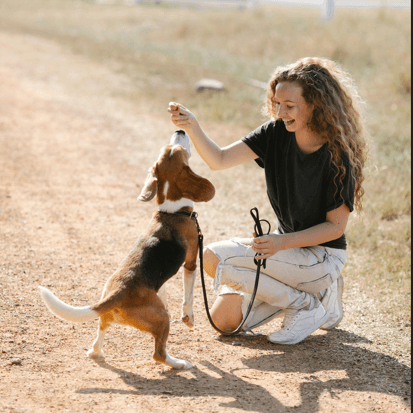Dog Training Plan, you will embrace a friend who can give you loyalty, love, and joy. But without proper training, your dog can pick up bad habits, and you can both end up feeling frustrated. An effective dog training plan is vital to a happy, well-adjusted pet.

Training your dog can be neither difficult nor time-consuming. Once your dog has a plan and techniques, he can be trained to be a loving, obedient, and wonderful canine member of your family. With the help of this dog training guide, you will learn simple steps that can make dog training fun!
Effective Dog Training Plan: Why You Need a Plan and How to Create One
A good dog training plan needs to:
- Prevent behavioral problems: A dog to whom basic commands have not been taught will develop destructive behaviors like chewing, excessive barking, and even aggression.
- Improve communication: During training, there is clear communication between you and your dog so that they can understand your expectations.
- Increase the bond: Training is something you do together, which helps to build trust and strengthens the relationship.
- Encourage safety: Well-behaved dogs are much more manageable, particularly in social situations, lessening the risk of them being hit by cars or attacking other animals.
Following a plan keeps you on track and focused and walks you, step by step, through the entire training process.
Step 1: Defining Specific Objectives for Training
Define Your Goals It’s important to define your goals before you start any training. Think about what you want your dog to do. Are you interested in training basic obedience, addressing behavior problems, or advanced skills with your dog? Your training methods will depend on your goals.
Sample Training Goals for a Dog:
- They need to know: sit, stay, come, heel.
- Behavior Issues like barking, chewing, or jumping will be prevented
- Advanced Tricks: fetch, agility training, or tricks.
- Socialization: Ensuring your dog is relaxed around new people, dogs, and places.
Having a plan and writing down your goals will create purpose and help you stay focused on the big picture.
Step 2: Creating a Dog Training Schedule
In order to train your dog to a certain behavior, make sure to be consistent. Since dogs love routine, creating a schedule for training sessions is important. A basic dog training schedule to help you get started:
| Training Time | Training Focus | Duration |
|---|
| Morning (7:00 AM) | Basic Commands (Sit, Stay) | 10-15 minutes |
| Midday (12:00 PM) | Leash Training | 10-15 minutes |
| Afternoon (4:00 PM) | Playtime & Socialization | 20 minutes |
| Evening | Behavioral Issues (Barking) | 10-15 minutes |
Step 03: Selecting Effective Dog Training Plan Techniques
Also, there is no universal approach to dog training. Each dog responds differently to each method. Here are a few common training methods:
Positive Reinforcement
Positive reinforcement is the most effective and humane way of training dogs—and most other animals, for that matter. It entails rewarding your dog for great behavior to increase their chances of repeating it. Rewards can be treats, praise, toys, or even a belly rub.
Clicker Training
This is called positive reinforcement (for more information on positive reinforcement, see our guide on clicker training). The clicker sound indicates precisely when your dog does something right and that a reward will soon follow. This process is particularly useful for teaching trickier behaviors or tricks.
Leash Training
Leash training—training your dog to walk on a leash. Alternative: The intent is to teach them not to pull, lunge, or jump to walk. Begin in quiet sha’ban with short sittings, before moving on to the more crazy places.
Crate Training
What Is Crate Training? Crate training is getting your dog to see their crate as their safe space. It’s a great way to make housebreaking easier, prevent destructive behavior, and give your dog a resting place.
Step 4: Ways to Train Your Dog Basics
Once you finalize your goals, schedule, and method of training, you can start by teaching your dog basic commands. Here are some basic commands all dogs should know:
Sit Command
- How to teach it: With a treat near your dog’s nose, move it up. As your dog tracks the treat, their rear should naturally lower to the ground. As soon as they sit, immediately reward them with treats and praise.
- Why it matters: A dog’s “sit” command can help dog owners establish control during high-energy moments and potentially dangerous scenarios.
Stay Command
- How to teach it: With your dog sitting, open your hand in front of them and say “Stay.” If your dog remains in place, give them a treat.
- Why it’s important: The “stay” command is a really important one to have during training, mainly because it’s useful in a ton of everyday situations, particularly when you’re out in public with your dog or you want to make sure they stay out of danger.
Come Command
- How to teach it: Use your dog’s name and the command “come,” all while you are in an excited voice. When they come to you, give them a reward.
- What it is: The “come” command is crucial for safety. It’s vital for your dog to know he can return to you when you call, especially in moments of danger.
Step 5 If you need to deal with behavioral problems
Dog training isn’t limited to just teaching a dog to follow commands—there is also behavioral problem resolution involved. This can be excessive barking, jumping on guests, chewing, and housebreaking.
Barking
In some cases, excessive barking is an indicator of boredom, anxiety, or insufficient exercise. Counter this with plenty of mind stimulation, including toys, daily walks, and training exercises.
Jumping
To help, if your dog jumps up on people, teach them to greet others politely by rewarding the “sit” command when they’re near someone. Encourage calm behavior and redirect them if they jump.
Chewing
Chewing is a natural behavior, but can also turn destructive. Make chew toys available, and when your dog starts chewing on furniture or your shoes, give a command to redirect them. She encourages them when they chew on appropriate items.
Now you need to focus on Step 6: Advanced Training and Socialization.
As soon as basic commands are learned, advanced training comes next. This can include agility courses, for example, scent detection, or teaching your dog entertaining tricks, such as “rollover” or “play dead.”
Also, socialization is very important. Accustom your dog to different hands, noses, and scenarios. They will build confidence, and therefore fear-based behavior will be minimized. Effective Dog Training Plan.
Take home: Stay the course with your dog’s education journey
Teaching your dog is a continual process throughout his life. It takes patience, consistency, and love. Dog training plan Full circle: By adhering to a plan, you can become a better, more confident, happy companion into middle age and beyond. As always, make sure to celebrate small milestones along the journey and adjust your approach as your dog’s needs change.
*FAQ: Frequently Asked Questions about Dog Training
Q: How long does it take to train the dog?
A: How long it takes to train a dog varies with the dog’s age, breed, and temperament. But most dogs can master basic commands in 4 to 6 weeks with regular training.
Q: My dog doesn’t respond to training. What now?
A: If your dog isn’t responding, try changing up your training methods or reaching out to a professional trainer. Some dogs may require a little more of a gentle approach, while certain dogs may respond better to other techniques such as positive reinforcement.
Q: Can I train an older dog?
A: Yes! An older dog is never too late to train. Dogs are a little harder to adapt but can, over time, learn new habits and commands if one practices consistently and patiently.

